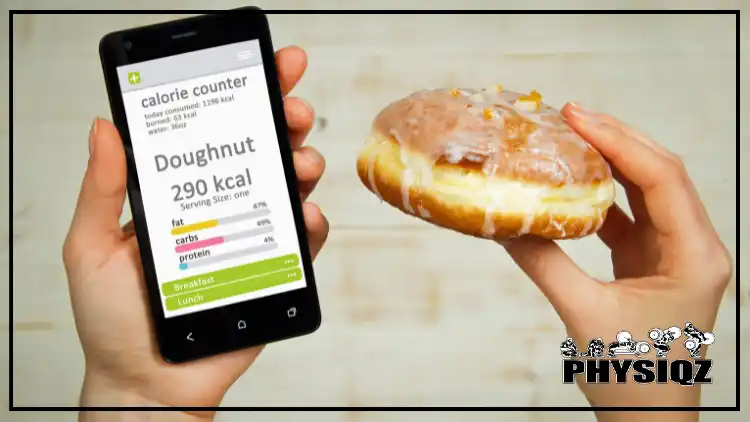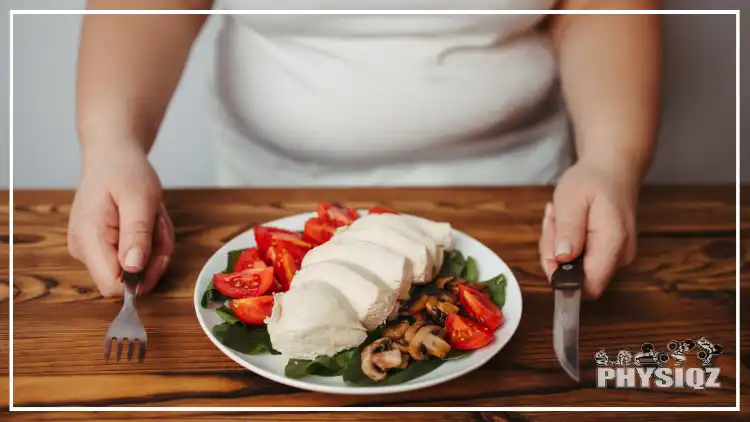
When calculating how many calories to consume on a cheat day, consider your weekly calorie allotment to ensure that a single day doesn’t undo a whole week of dieting. The answer may not be what you initially think. In other words, it’s easy to erase all the progress of one week in single day if you go overboard so this should be avoided at all cost.
So when the term cheat day comes to mind, just know that plenty can be consumed if it’s done correctly and with proper planning.
Determining Calorie Intake for a Cheat Day
Since weight loss and weight gain are determined by the balance of calories in versus calories out, the number of calories you can have on a cheat day depends on your total daily energy expenditure (TDEE).
TDEE is based on Basal Metabolic Rate (BMR) which is how many calories a day are burned by the body doing basic functions as well as calories burned through exercise. This total daily allotment of calories is a guideline of how much an individual is able to eat without gaining weight, while any food consumed below that calorie count is referred to as a deficit.
If a dieter is unaware of their TDEE, the U.S. Department of Health and Human Services has provided a calorie calculator to help determine the number of calories needed to maintain or lose weight.1
Once TDEE is calculated, pinpointing a cheat day calorie goal that will minimally disrupt maintenance or progress will be easier.
As an example, if a dieter has a total daily energy expenditure of 2000 calories and is working to cut out 200 calories a day, that’d put them at 1800 calories on non-cheat days.
Let’s say you’ve been doing this for six days, that’s 200*6 or negative 1200 calories for the week. Or a weekly calorie deficit of 1200.
So on the seventh day, you eat 3200 calories – or a surplus of 1200 more calories than your maintenance calories (TDEE) of 2000 – then the entire week of progress is erased.
To avoid all of this, dieters should either not consume more than their TDEE which is 2000 in this example, even on cheat days. And if they want to eat more than their TDEE or maintenance calories, then weekly allotments should be considered.
Can I Plan in Advance for a Cheat Day?
As previously mentioned, weekly calories are just as important as daily calories, so, as not to eliminate loss of progress, it could be beneficial to consider caloric needs for the week when planning in advance and determining how many calories for a cheat day.
An easy way of setting up a successful cheat day is potentially cutting back daily calories by around 100 per day. If this is done most days of the week, it would allow for an extra 300 to 600 calories when it’s time to indulge.
If a cheat meal is all that is desired, simply eating smaller meals that day can leave room for extra calories; then, the remaining calories can be used as desired up to TDEE or, like the example above, up to 2000 calories.
By using one of the above methods or even a variation, negating the calorie overage before the cheat day even occurs can help give a buffer and help progress continue without interruption.
Is it Okay to Go Over Normal Calories on a Cheat Meal or Cheat Day?

Source: piotr_malczyk via Canva.com2
Going over calories on a cheat day, or any day is not a question of morals. However, it can, as mentioned above, impact progress and might cause guilt or regret. So yes, you can go over normal calories on a cheat day, but it should be done with caution.
What might be more beneficial for both mental and physical health, is to either plan for a cheat day by adjusting calories ahead of time or deciding to stay within the calculated total daily energy expenditure.
How Often is it Okay to Have a Cheat Day: Once a Week or Once a Month?
Trying to decide how often to incorporate a cheat day comes down to personal habits, triggers, and determining whether cheat days are more helpful or harmful in the long run.
For those that typically eat clean and don’t struggle with going over normal calorie goals, working on a weekly cheat day is reasonable and could contribute to staying on track for longer. If having a cheat day once per week begins to bleed into an additional day or two, it may be smart to cut back to 2 or 3 cheat days per month to limit extraneous calorie intake.
Unfortunately, staying on plan for some might be more of a challenge, and while a weekly cheat day might seem like a helpful tool, it could unintentionally lead to additional missteps throughout the week and cause a dieter to further stray from their daily caloric goals they might already be having trouble adhering to.
If this sounds like a familiar scenario and the mind keeps saying “I will never lose weight”, when trying to determine how many cheat days a month to allow, it may be best to start out small and plan for a cheat meal instead. While it is still possible to overindulge in a cheat meal, it is, hopefully, easier to recover from and get back on track.3
How to Work Cheat Days into Your Weight Loss Plan
As mentioned earlier, when considering the number of calories to consume on a cheat day, it’s a good idea to plan ahead to make sure you don’t exceed your daily or weekly calorie limit. While cheat days are commonly looked at as a “yes day” to food, the truth is, that removing every limit from meals can be dangerous.
Some studies have associated cheat days with binge eating disorders, so finding a healthy balance to work in desired foods without feeling deprived while not overdoing it is critical.4
Adjusting cheat meals to make them slightly healthier, exercising to counteract excess cheat day calories, and adjusting the calorie allotment for the week are all feasible weight loss solutions that can be incorporated within a cheat day plan to maximize progress.
Try to Make Your Cheat Meals Healthy-ish
Just because it’s called a cheat day, doesn’t mean health has to go completely out of the window. Learning how to live a balanced life leads to success, so even incorporating nutritious foods during a cheat day will be beneficial and could contribute to coming out ahead.
Having meals that are special and delicious but still include all the nutrients needed for a well-balanced diet may be an optimal way to satisfy cravings during a cheat day.
For someone following a keto diet, a dinner that consists of steak and shrimp, a baked sweet potato, and a Caesar salad is most likely not something that is indulged in on a weekly basis, so incorporating it into a cheat day can still satisfy the urge of eating something extra rich and delicious without worrying too much about how many extra calories or carbs are consumed.
Eat Small Portions of “Unhealthy Food” on Cheat Days
Donuts, ice cream, and french fries are all foods that are typically obsessed over and common additions to a cheat day; the problem is, they are all empty calories and do little to satisfy hunger.5
Instead of filling the entire cheat day with these types of foods, consider incorporating a healthy pairing or two.
- Breakfast – Instead of eating a box of donuts, try to only indulge in a single donut and add a veggie and egg scramble to the side to get needed protein and fiber.
- Lunch – Order the french fries, but consider ditching the greasy burger and opt for a grilled chicken sandwich with avocado to benefit from the healthy fats.
- Dinner – Binging on extra cheese and pepperoni deep dish pizza might sound good initially, but maybe start with a couple of thin crust pieces and a side salad to satiate the craving but benefit from skipping out on all the extra calories.
- Dessert – While ending a cheat day with a giant brownie sundae is tempting, a swap for frozen yogurt with fun toppings might hit the spot while significantly reducing the sugar content.
While it is safe to consume these “unhealthy” foods in moderation, finding a compromise, as laid out above, can be a healthy way to work them into most lifestyles.
Burn Those Excess Calories Off
If a cheat day is on the horizon and the worry of extra calories is causing some concern, instead of just being tired of being fat, think about hitting the gym for a bonus class, going on an extra run, or scheduling a hike to increase the daily or weekly calorie deficit.
Cheat days without having a plan to negate the calories might cause a dieter to gain a pound or two. Increasing activity will not only burn off the excess calories, but it will serve as accountability.
Eating calories is a great deal easier than working them off. For example, eating a single piece of chocolate cake, which is roughly 350 calories, will take about 5 to 15 minutes. On the other hand, to burn 350 calories, a 150-pound person would need to hike for almost an entire hour.
When figuring out how many calories to consume on a cheat day, keeping in mind the effort you’ve put into earning or burning off calories can help you stay on track.
Don’t Go Over Your Daily or Weekly Calorie Allotment
Keeping track of daily or weekly calories is helpful regardless of whether someone is looking to maintain or lose weight. Incorporating a cheat meal or day is more sustainable when these calorie goals are kept in check.
Not paying close attention to calorie consumption, especially when wanting to add in a cheat day, could result in ruined progress and unwanted weight gain.
Assuming someone is following a 1200-calorie diet and adds a weekly cheat meal of 2200 calories, at the end of the month, they might have racked up an additional 5000 calories if the cheat days were not adjusted for.
Plan Your Cheat Days to Stop Worrying About Calories
While not every life event is planned in advance, bigger days, such as holidays, birthdays, and vacations, are all things that have held a place on the calendar for quite a while. Planning how many calories to consume on a cheat day during these events can reduce stress instead of just reacting as the days arrive.
Looking at the coming weeks and months and pinpointing days that could hold temptation can help by allowing time to prepare and plan in advance. For instance, if an important birthday and holiday fall within the same month, skipping a typical cheat day for that month in lieu of those two events might help control calories and reduce the likelihood of overages.
In addition, if you know your cheat day is coming up, you can eat healthy meals on the days before and after to ensure you don’t go overboard when the cheat day arises.

Source: Vadym Petrochenko via Canva.com6
Mitigate Hunger Cravings & Lessen The Temptation of Cheat Days
Cravings are inevitable and a part of life that most, if not all, people are accustomed to either fighting or giving in to. Sometimes, these cravings can be tempered and learning how to do that, along with why they are even there in the first place, can be helpful in a health journey.
Instead of giving in to the urge to eat a specific food right away, delve into the reasons behind your cravings, such as wanting cereal or chips.7
If the answer to these questions doesn’t lead back to hunger, it may be best to find a different way to respond to those desires.
- Drink More Water – Being thirsty can often be mistaken for hunger or a craving for food; drinking a glass or two of water before succumbing to temptation may reveal that there were no hunger cravings after all.
- Be Mindful – Being mindful when eating is a practice that can lead to successful eating habits and a healthier lifestyle. Think about whether legitimate hunger is being felt, or just the desire to snack.
- Get Up and Do Something – Boredom can lead to cravings and emotional eating, so occupying time with activities that don’t include food may help bypass feelings of wanting to eat.
- Relieve Stress – Stress eating is a common cause of cravings and can be lessened by releasing some tension. Speaking to a therapist, letting off some steam during a workout class, or just getting together with friends could aid in getting through times of obsessing over food.
Constant Cravings Might be Diet Fatigue
Struggling to resist junk food and sugar, even after indulging in a cheat meal or day, suggests that diet fatigue might have set in. Persisting with a diet despite this fatigue can lead to a lack of interest in eating healthily and exercising. Rather than advancing towards your goals, this approach may actually undermine them.
To avoid losing traction during diet fatigue and giving up on weight loss, transitioning into a caloric maintenance phase to boost metabolism might help curb cravings. A maintenance phase increases the calorie allotment to equate to TDEE and will allow for more food, which should help to decrease cravings and remove the constant desire for cheat days.
While cheat days are typically a welcome addition to most dieters’ meal plans, knowing how to incorporate them in a healthy way is important. Limiting your calorie intake on a cheat day, rather than indulging in mindless eating, can help maintain balance and still allow you to achieve your weight loss goals.
References
1U.S. Department of Health and Human Services. (n.d.). Body Weight Planner | NIDDK. National Institute of Diabetes and Digestive and Kidney Diseases. Retrieved August 11, 2022, from <https://www.niddk.nih.gov/bwp>
2piotr_malczyk. “Calorie counter concept.” Canva. Accessed 8 April 2023. <https://www.canva.com/photos/MAERqHza7j0-calorie-counter-concept/>
3Harvard Health Publishing. (2020, December 1). Tips to cheat safely on your healthy diet. Harvard Health. Retrieved August 12, 2022, from <https://www.health.harvard.edu/staying-healthy/tips-to-cheat-safely-on-your-healthy-diet>
4Ganson, K., Cunningham, M., Pila, E., Rodgers, R., Murray, S., & Nagata, J. (2022, August 6). Characterizing cheat meals among a national sample of Canadian adolescents and young adults. PubMed. Retrieved August 12, 2022, from <https://pubmed.ncbi.nlm.nih.gov/35933394/>
5University of Michigan. (n.d.). Empty Calories. Michigan Medicine | University of Michigan. Retrieved August 12, 2022, from <https://www.med.umich.edu/1libr/Mhealthy/WhatAreEmptyCalories.pdf>
6Harvard School of Public Health. (2022). Cravings | The Nutrition Source | Harvard T.H. Chan School of Public Health. Harvard T.H. Chan School of Public Health. Retrieved August 12, 2022, from <https://www.hsph.harvard.edu/nutritionsource/cravings/>
7Petrochenko, Vadym. “Diet concept, healthy lifestyle, low calorie food.” Canva. Accessed 8 April 2023. <https://www.canva.com/photos/MAESHpDJV_k-diet-concept-healthy-lifestyle-low-calorie-food/>